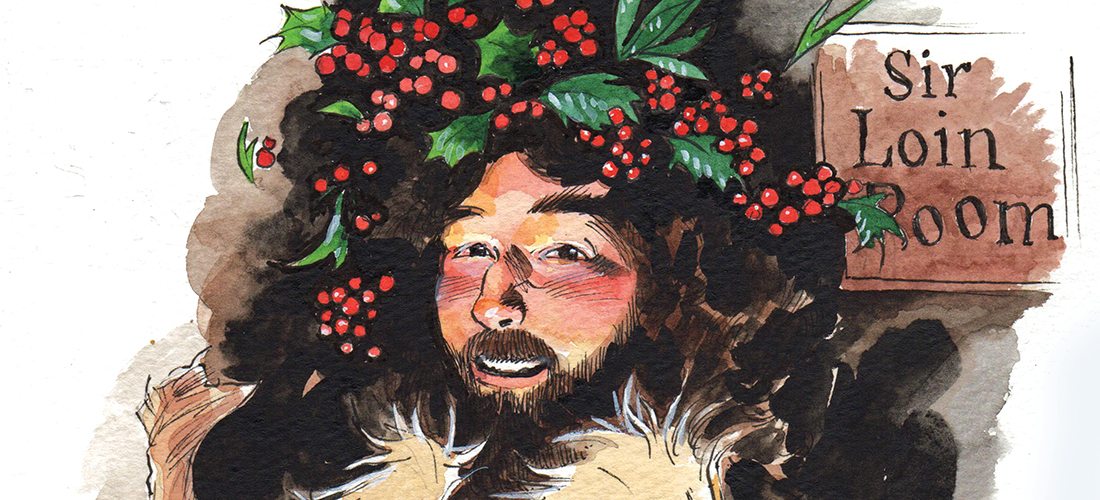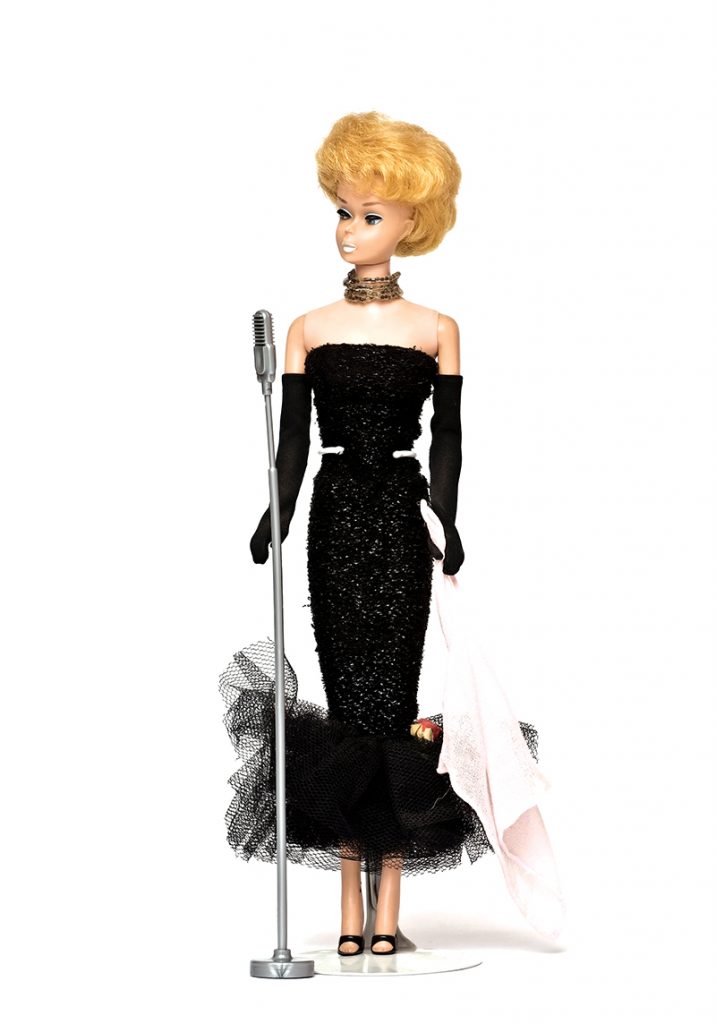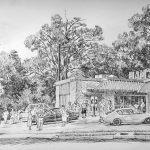
How the spirit(s) of the hippest holiday in memory were dampened by a state court system determined to play Ebenezer Scrooge
By Billy Ingram • Illustration by Harry Blair

The year 1966 brought the grooviest Christmas season Greensboro will likely ever see, a time of unprecedented prosperity in a nation embracing a Space-Age future, in an era when the provincial collided with the outlandish — at a moment that just might have been the tipping point when Pop became forever enshrined as America’s dominant culture.
The Gate City was basking in the dawn of the Go-Go Years. At a time when you could purchase a Moravian star for $3 at The Corner on Tate Street, Thalhimers Department Store would custom-decorate your Christmas tree . . . if you opted for a natural one. Original model aluminum trees with a rotating lighted color wheel, sought-after collector’s items today, were at the time considered the height of tackiness — or chic, I’m not sure which. To each his own at Christmastime, right? When I was a kid our neighbor Jane King absolutely hated blinking lights on a tree. Naturally dad made sure there was at least one bulb that flashed on and off just to get a reaction from her that was as much a holiday tradition as can-shaped cranberry sauce.
Every evening hundreds motored way out High Point Road to cruise slowly past Pilot Life’s Nativity scene (currently on display at Greensboro College). The first reception at a decrepit Blandwood Mansion kicked off a fundraiser that would eventually save the property, leading to our modern-day Preservation Greensboro. City and county leaders got behind a referendum that would raze the 56-year-old courthouse to erect a new municipal center.
The affairs of the Court — with its back-and-forth rulings on the use of alcohol — would be on everyone’s minds, however as the twelfth month of that pivotal year arrived. Especially on the minds of convivial gals in pillbox hats and little black dresses, or daring new mini-skirts, and guys in Sansabelt pants and velour mock turtlenecks, fashions of the day that would ultimately descend into that hippy-dippy madness we think of as the late ’60s.
But in ’66 mock-Ts and LBD’s were de rigeur for restaurant patrons and tipplers, who’d walk into restaurants with brown bags or knitted cozies containing the hooch of their choice, which a bartender would take and measure into cocktails, then charge for set-ups. Cin Cin! Bottom’s Up! Here’s mud in your eye!
Since 1935, a state-controlled Alcohol Beverage Control distribution and tax system had been in effect for those communities passing referendums allowing liquor sales. That didn’t happen in the Gate City until 1952. Even so, you couldn’t stroll the ABC store aisles to make your selection as you can today; that was done by no-nonsense clerks who kept the merchandise behind a counter. Moreover, bars and taverns couldn’t sell liquor throughout the state, so a wink-wink, nudge-nudge practice known as “brown bagging” was instigated. So called “bottle clubs” like the Sir Loin Room inside McClure’s Restaurant in the Summit Shopping Center allowed repeat diners to store their booze on the premises. Country clubs offered liquor lockers to their members.
While swinging singles were out swilling, kids were left chilling to primetime shows, all broadcast in “living color” for the first time ever, giving many families an excuse to rush out and purchase top of the line Curtis Mathes console television sets retailing for around $700 at Steele & Vaughn (where Pryor Brewery is today). A dented model from the Sears Outlet Store on Lawndale was a money saving option for cheapskates like my dad.
Equally appealing to impressionable young minds as Bewitched and Batman were the commercials. Toymakers opened the spigot to feed the insatiable maw of Baby Boomers coming of age, expanding the fantasy universe of established best-sellers like G.I. Joe, Johnny West and Barbie, while launching new franchises such as the inexplicably popular Suzy Homemaker appliance line that included an oven, washing machine and dishwasher. Seemingly reinforcing the stereotype that a woman’s place was in the home, how could these little girls imagine they’d be working two jobs when they grew up?
What kids hollered most for, introduced in 1966: G.I. Joe Astronaut with floating capsule, Debutante Ball Barbie and her mod cousin Francie, Twister, Batman Utility Belt with Batarang and Bat-Cuffs, 330-piece Fort Apache battle set, Baby Teenie Talk with moving lips, Major Matt Mason and Captain Action action figures, See ’N Say, Lego Car Repair Shop, Spirograph, Operation, Creepy Crawlers Thingmaker, those Show’N Tell ersatz-TV record players synced to a built-in slide projector, the Addams Family Thing Bank with a little green hand that snatches the coin away.
Weaponry and subterfuge were all the rage for kids as a Cold War gripped the nation. The Mattel Zero M was by appearances a transistor radio that, at the touch of a button, expanded into a cap firing assault rifle. Along with a Luger that transforms into a submachine gun, the ISA 07-11 Super Spy Attache Case featured a built in telescope, working hidden camera and walkie-talkies that could transmit a signal up to a 1/4 mile away as long as there were no impediments like walls or buildings, which was kinda the whole point so they were basically worthless. For the purist there was Mattel’s M16 Marauder, just like big brother carried in Vietnam, with realistic Braap-Braaaaaap, Brap Brap sound. Nothing compared to the Johnny Seven O.M.A. (One Man Army) by Topper, the ultimate killing machine with a grenade launcher, anti-tank weapon, antibunker missile, armor-piercing shell and detachable pistol for when the fighting gets close.
For $70 Santa scored a chrome-plated Schwinn Fastback Stingray bike with a 5-speed stick shift and elongated banana seat; the Slik Chik model for girls came with a flowered wicker basket up front. Low-riding youngsters rolled in style in AMF’s Mustang metal pedal car with spinner hubcaps. If Dad wanted his own ’66 Mustang, Friendly Ford was all too happy to hand over the keys for around $2,200.
Ah! Nothing succeeds like excess! (I wish I’d thought of that line first.) Just ask His Royal Greenness. Dr. Seuss’ How the Grinch Stole Christmas! aired on TV for the first time in 1966, and as mean a one as Mr. Grinch was, it was the N.C. Supreme Court, with hearts two sizes too small, that handed down a draconian ruling that threatened to torpedo the holiday season, criminalizing perfectly normal behavior while setting up a situation where anyone could be hauled off by police for re-gifting that fruitcake from Aunt Betty.
Wait, what? Stick with me . . .
North Carolina has always had a tortured history with alcohol. The state enacted Prohibition a full decade before the nation followed suit in 1919. The General Assembly passed the Turlington Act a few years later declaring that the consumption of spirits was allowed only in the privacy of one’s own home (medicinal and religious uses exempted). How it was supposed to get into the home when it was illegal “to manufacture, sell, barter, transport, import, export, deliver, furnish, purchase or possess intoxicating liquor” was anyone’s guess but it led to a labyrinth of shady practices and elaborate delivery schemes, one of which evolved into what we now know as NASCAR. Small wonder, spiriting bathtub gin from one surreptitious rendezvous point to another was as much sport as commerce. For three decades Greensboro residents purchased liquor in dark alleyways, carefully hidden inside a bushel of apples bought on Commerce Street or slipped surreptitiously from under the counter at Fordham’s Drug Store on South Elm, until the aforementioned brown bagging became a common practice in ’52. For almost fifteen years it seemed a reasonable coexistence between wet and dry forces had been reached.
That peace was shattered on December 1, 1966, however, when citizens awoke to the news that the N.C. Supreme Court had unanimously ruled brown bagging unconstitutional, that “the Turlington Act is still the primary law in every area which has not elected to come under the ABC Act.” Once again a person could possess liquor only in their own private dwelling or while traveling to and from the ABC store. No more than a gallon of liquor could be transported across state lines, any more than that in any one place carried with it the presumption of intent to resell.
Potent potables could be served to guests in one’s home but nowhere else, not even a rented hall or private club hosting a wedding reception or holiday party. It was suddenly illegal to bring a $2.79 pint of Old Crow to someone’s house (as it should be), present a giftbox of Chivas Regal to your dinner host or give a bottle of Smirnoff to your uncle. Gifting baked goods containing rum or brandy? They may as well have been pot brownies — you’re going to jail, Grandma!
Mass confusion ensued. Restaurateur J. W. McClure expressed a frustration felt by many, “I don’t know what the laws are and I’m afraid nobody does either,” he declared with exasperation. When a Mecklenburg judge suggested the ruling could be postponed for the season, the State Supreme Court, with “unprecedented swiftness,” dispatched a marshall from Raleigh to Charlotte with a copy of the proclamation to be recorded immediately at the Mecklenburg Superior Court, something no one had ever recalled happening before. Their adjudication was effective immediately and would not be forestalled, not even by the Supreme Court in Washington D.C., which refused to intervene. The state ABC Board announced that no warrant was required for their officers to infiltrate any venue where festivities were underway to enforce compliance and arrest offenders if necessary.
Just so there was no doubt about the seriousness of this decree, the Greensboro and Sedgefield country clubs were formally notified that, from that point forward, beer and wine alone could be served on the premises. The Sand Hills Country Club dismantled their signature bar shelves stocked with members’ bottles. The manager of the Reidsville Elks Lodge declared, “This is going to bring back the hip flask and the lady with the big pocketbook.”
The effect on the hospitality industry was swift and devastating. McClure’s Steak House saw receipts drop 59 percent, forcing the closure of its members-only bottle club. Reservations for New Year’s Eve parties at nightclubs and eateries plummeted by as much as two-thirds. Supper clubs suffered the most. The Tropicana ceased operations entirely while Fred Koury’s Plantation experienced a 70 percent revenue drop. Waitstaff at Cellar Anton’s, McClure’s and The Colony grew used to diners, those they had left, sneaking back to their cars in the middle of a meal for a quick nip.
That December, Harold Driggers and the Six Key Brothers were opening for Jerry Butler at the Plantation when they recorded a regional hit single at Copeland Sound Studio in Greensboro called “Brown Baggin’”, a Paramount Records release riffed on an earlier soul tune, “Barefootin’”. It quickly became the second most requested song on WCOG with scintillating lyrics:
I just heard Mr. Fred say I know what to do.
I’ll brown bag if you brown bag too,
And if the brown baggin’ crowd is big enough,
I don’t think they’ll try to lock us all up.
Of course, to toddlers and teetotalers this was all much ado about nothing, for most folks the holidays soldiered on without a hitch despite a dampening of spirits. Shoppers jockeyed for parking spaces downtown in front of Prago-Guyes and Belk, or a few blocks down South Elm at Tiny Town Toyland. Big Bear at Lawndale Shopping Center prepared family sized Christmas dinners for $8.95. Moon Wyrick brought up the rear as Santa in the Holiday Jubilee parade following WFMY’s Old Rebel and Pecos Pete waving from a Model T Ford, while, just up ahead, Little Miss Sunbeam tossed miniature loaves of bread to an eager crowd from her fanciful float.
As it happened, there were no arrests locally for unlawful partying but the ABC board reported lower sales than the previous December. Within a few months the 1967 legislature bent to the will of the people and reinstated brown bagging. It wasn’t until two decades later that Greensboro residents could walk into a bar or eatery and order a drink without a bottle in hand, a concept known fifty years ago as “whisky by the drink.”
My most cherished memory of Christmas ’66, besides that cool Lost in Space Roto Jet Gun that rained spinning plastic projectiles on my younger siblings for weeks afterward, was the storm Christmas Eve that delivered nearly 3 inches of snow just as St. Nick began making his rounds. It was a White Christmas that found children of all ages hopping onto new Flexible Flyers, carving deep ruts into the Greensboro Country Club golf course while others rocketed down slippery slopes on Northwood in Latham Park or down Fairmont in Lake Daniel.
In a scant few years the Big Wheel rendered pedal cars and tricycles obsolete, and Barbie had long ago stopped hanging out with her hard-partying cousin Francie. Still, an amazing number of 1966 sensations are still with us. Spirograph, Twister, Operation and sophisticated Lego systems haven’t lost their allure. I even saw one of those Addams Family banks not long ago, although I suspect there won’t be many Batarangs with handcuffs under trees this Christmas. And who needs walkie-talkies and hidden cameras? We carry them around everywhere we go. OH
Billy Ingram was so far into Santa he wrote and starred in five hours of Christmas specials for the Bravo network in 2005—06 and portrayed Father Tobias in A Killer Christmas Carol film. He has an extensive tribute to Christmases of old on TVparty.com.





